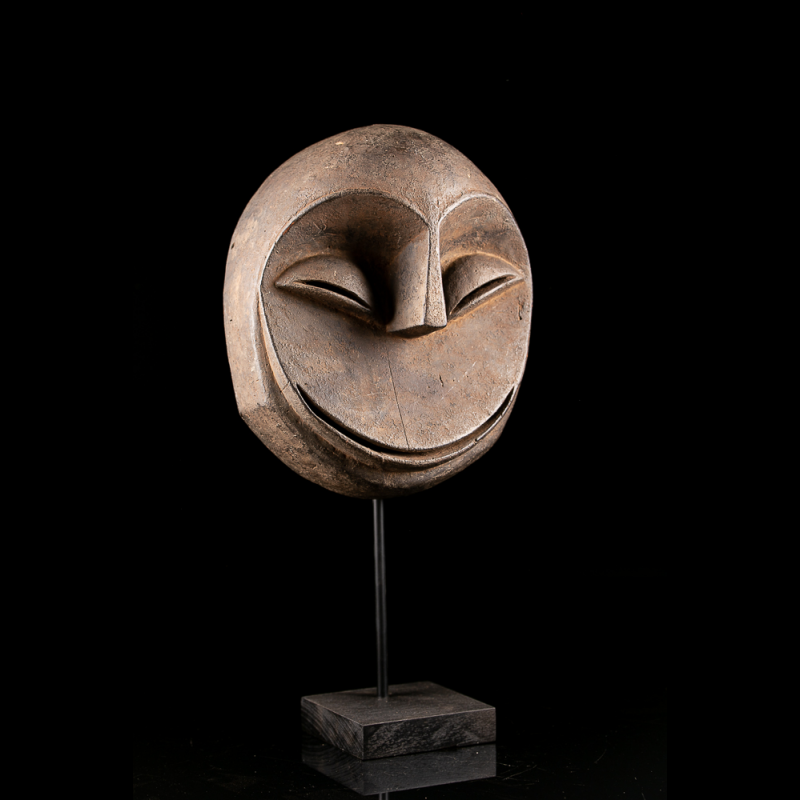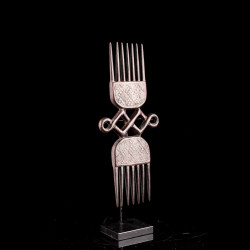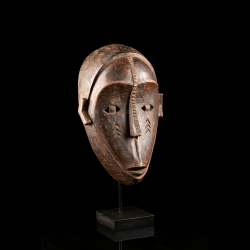












African Masks of the So'o type were unknown to Westerners until the 1970's, even though some of them most probably date from the early twentieth century.
The term Soo (sokomotu in Swahili) refers to the chimpanzee, and the complete name of the mask is mwisi (spirit-receptacle object) gwa soo.
The Hemba do not consider the chimpanzee very sympathetic.
As an inhabitant of the lusuku (wilds/brush/forest), it is avoided by the Hemba and perceived as envying certain human abilities and lusting after human women. The wide-open mouth of the so'o should not be mistaken for a smile.
To the Hemba, it would suggest something strange and horrible: a mouth defiant of any rules of decorum.
The same applies to the raised eyebrows of the mask, which, in Hemba physiog-nomical language, pertain to madness, anger and savagery.
Though closely related to a creature from the lusuku, the mwisi gwa so'o also has a relationship with the village, which in turn belongs to the hanza or civilized space.
This is notably expressed in the mask's costume, which can, for example, comprise the hides of both wild and domestic animals. When the mask appears in a village, the soo never speaks. The only noise connected with him comes from the little bells on his legs. His armless appearance is disconcerting; the broad barkcloth cape conceals his arms completely.
One of the main public interventions of this mask occurs during ubuzha malilo funeral ceremonies, which can be defined as a process of reconciliation between the living and the dead. During an ubuzha malilo, the so shows two different facets of its person-ality.
The first pertains to the "savage". During this phase, the soo frenziedly pursues the youngest spectators and pregnant women.
In a second phase, the so'o is tamed and becomes more playful. He is then accompanied by professional drum players. Now more a jester than a boogeyman, he is often joined in dancing by spectators.
This evolution in the character of the so'o is understood as an allegory of death itself, which shakes up the community when it strikes and requires certain rites before things can return to normal.
During the ubuzha malilo, the first phase of the so'o corresponds to the disturbing nature of death and the second to its taming, integration and, ultimately, acceptance.
Data sheet

African Masks of the So'o type were unknown to Westerners until the 1970's, even though some of them most probably date from the early twentieth century.
The term Soo (sokomotu in Swahili) refers to the chimpanzee, and the complete name of the mask is mwisi (spirit-receptacle object) gwa soo.
The Hemba do not consider the chimpanzee very sympathetic.
As an inhabitant of the lusuku (wilds/brush/forest), it is avoided by the Hemba and perceived as envying certain human abilities and lusting after human women. The wide-open mouth of the so'o should not be mistaken for a smile.
To the Hemba, it would suggest something strange and horrible: a mouth defiant of any rules of decorum.
The same applies to the raised eyebrows of the mask, which, in Hemba physiog-nomical language, pertain to madness, anger and savagery.
Though closely related to a creature from the lusuku, the mwisi gwa so'o also has a relationship with the village, which in turn belongs to the hanza or civilized space.
This is notably expressed in the mask's costume, which can, for example, comprise the hides of both wild and domestic animals. When the mask appears in a village, the soo never speaks. The only noise connected with him comes from the little bells on his legs. His armless appearance is disconcerting; the broad barkcloth cape conceals his arms completely.
One of the main public interventions of this mask occurs during ubuzha malilo funeral ceremonies, which can be defined as a process of reconciliation between the living and the dead. During an ubuzha malilo, the so shows two different facets of its person-ality.
The first pertains to the "savage". During this phase, the soo frenziedly pursues the youngest spectators and pregnant women.
In a second phase, the so'o is tamed and becomes more playful. He is then accompanied by professional drum players. Now more a jester than a boogeyman, he is often joined in dancing by spectators.
This evolution in the character of the so'o is understood as an allegory of death itself, which shakes up the community when it strikes and requires certain rites before things can return to normal.
During the ubuzha malilo, the first phase of the so'o corresponds to the disturbing nature of death and the second to its taming, integration and, ultimately, acceptance.




